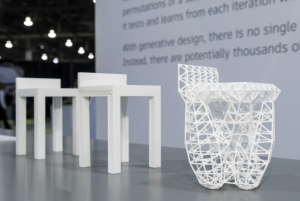SPOILER ALERT: technology is changing rapidly! That’s right—you heard it here first: the worlds of AEC, manufacturing, and media & entertainment are evolving as new tools create new design possibilities and enable new ways of working.
This shouldn’t be news to anyone who works in these industries. This rapid evolution has been going on for decades. And the pace of change is showing no signs of slowing down. If anything, it’s accelerating, and the changes that lie ahead over the next decade could be as great (or, let’s face it, greater) than the changes the past decade has brought. So buckle up.
As 2016 draws to a close and we prepare to kick off 2017, let’s take a quick look at the major trends that gained momentum over the course of the past year.
Meet your new design partner, your computer

We’ve been talking about generative design for a few years, but this year it started getting really, really real. With systems like Autodesk Dreamcatcher in beta, designers are realizing that, in just a few years, they could very well be shifting their role from solution creator to goal setter. Instead of thinking about how to solve a problem, they’ll be thinking about how to define it. And it’s not just for products anymore. Architects like David Benjamin are starting to use generative design to analyze traffic patterns, behavior data, and construction requirements to create optimized buildings that better serve the needs of the people in them.
Step into the screen
Virtual reality and augmented reality aren’t just for gamers anymore. With immersive design, VR and AR technologies enable designers and architects to experience their 3D models with greater spatial awareness and unparalleled interactivity. So you’re not just looking at a room on a screen, you’re walking through it. You’re not just looking at a new car design, you’re examining it from every angle at life size (with the help of some rad goggles). And with cloud-based collaboration, you can be in the same “room” as colleagues on another continent, working together seamlessly on the same project. That beats Pokémon GO anytime.

Shake hands with the robot
In days of old (like in 1990), roboticists would spend weeks, months, and years building a particular robot and teaching it how to do a given task. And for the most part, that was the only task it would ever be able to do.
 But here in the future (of today), adaptable designs are making robots capable of many tasks and intuitive software is making them easier to program. Together, that promises to make our robot friends more versatile and useful than ever. Plus, by equipping robots with new sensors, cameras, and modeling tools, we’re giving them the ability to observe what they’re doing, evaluate whether they’re doing it right, and adjust their actions (and even their programming) to achieve designated goals. We’re not far from robots that can actually learn to be more useful. And we just heard they’ve created a robot that can tell when a tomato is ripe by squeezing it. Think about that for a while.
But here in the future (of today), adaptable designs are making robots capable of many tasks and intuitive software is making them easier to program. Together, that promises to make our robot friends more versatile and useful than ever. Plus, by equipping robots with new sensors, cameras, and modeling tools, we’re giving them the ability to observe what they’re doing, evaluate whether they’re doing it right, and adjust their actions (and even their programming) to achieve designated goals. We’re not far from robots that can actually learn to be more useful. And we just heard they’ve created a robot that can tell when a tomato is ripe by squeezing it. Think about that for a while.
Data, data everywhere
Whether you’re designing a building, a car, or a toothbrush, there is more data than ever before, right at your fingertips. Powerful simulation tools built into Autodesk design platforms enable you to test your designs and reap performance data before you even create a prototype. And new cloud compute resources enable you to process that data in near real time. At the same time, new sensors and IoT technology in both finished buildings and products deliver performance and usage data long after the building is built and the product is sold, informing future design efforts. And we can do more with that data, too, thanks to generative design. The barriers between the digital and the physical are blurring.
Where will things go from here? It’s a safe bet that all these trends will continue to gain momentum. And new trends will almost certainly emerge. Check back with us in a year and we’ll see what 2017 has brought. Until then, friends, welcome to the future.





(0)